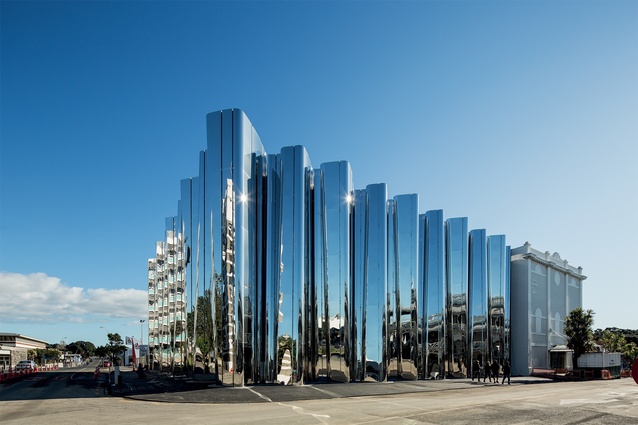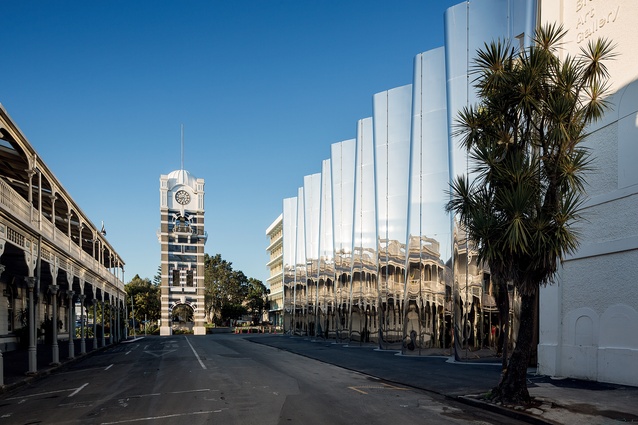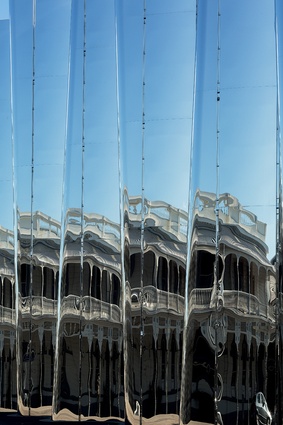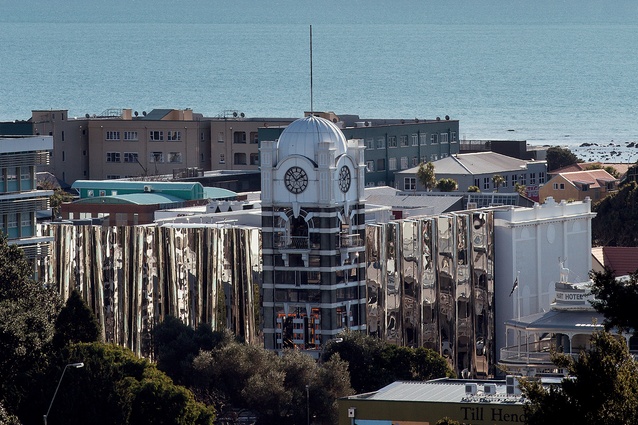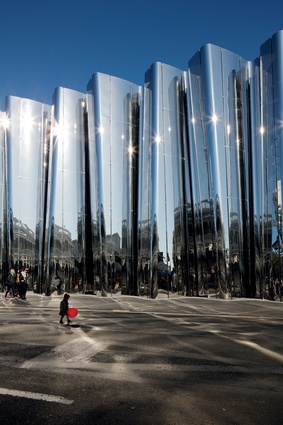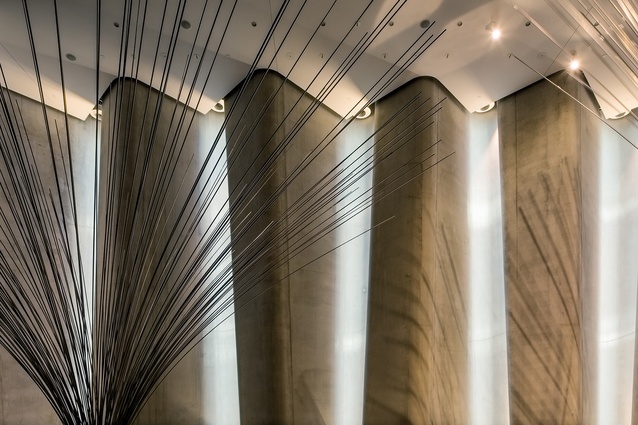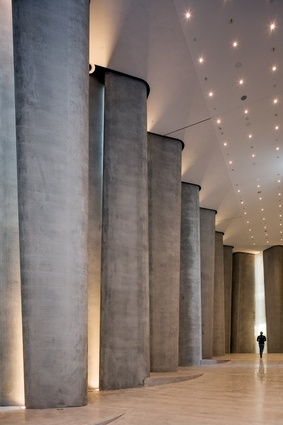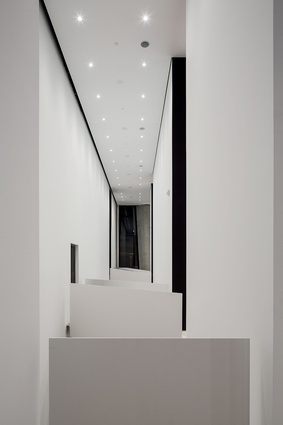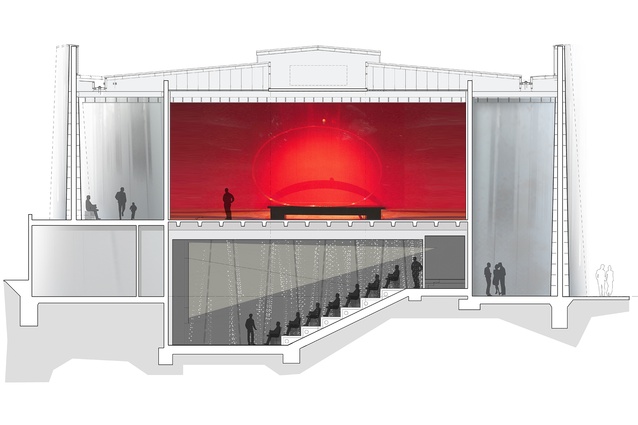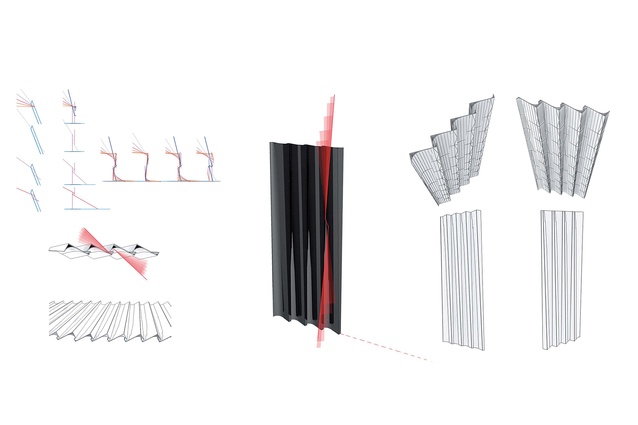Len Lye Centre
Antoni Gaudí once stated that his temple, the Sagrada Família in Barcelona, would “artistically represent the truths of religion and the glorification of God and His Saints”. In New Plymouth, the Len Lye Centre aims to create a modern version of a temple but, instead of devotion to God (or a bank or corporate HQ), this temple is devoted to the work of one artist, Len Lye (1901–1980). However, art isn’t the only deity here; an exciting communion between architecture and spectator has emerged also.
Visitors to the Len Lye Centre are arrested by a colonnade of gleaming stainless steel which rises up from the ground, in a repeating koru pattern, to form a magnificent theatre curtain. The shiny, undulating surface offers distorted reflections of everything that faces it: hallucinogenic patterns present the world as if through a giant kaleidoscope, which is apt when you consider that Lye is known for his devotion to ‘motion’ in the form of avant-garde films and kinetic sculptures.
Optical illusions banish indifference on the part of the viewer, who is forced to stop and watch the pink, fluffy clouds swirling past (or any other natural and built phenomena that present themselves: birds, cars, modernist office blocks and heritage hotels). People are invited also to recreate themselves in front of this architecture.
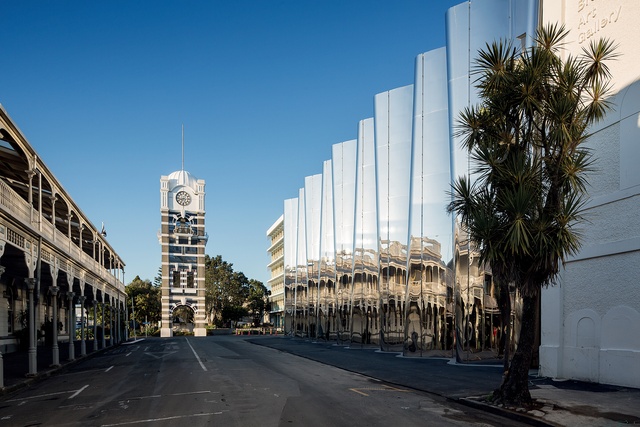
Patterson Associates’ plan for the Len Lye Centre was inspired by the megarons of the classical world, which can be seen in the procession of the layout: an interpretation of the colonnade, vestibule and inner sanctum. But also, it refers to Polynesian forms and ideas, continuing the practice’s thematic use of indigenous patterns to drive the design elements.
The façade consists of 20 monolithic 14m-high pre-cast concrete columns. Full-height, glazed panels draw light in between the columns during the day and reflect light back out at night. Each column weighs from 30 to 50 tonnes. “This project was really about the art of construction,” remarked Martin Stephens from Clelands Construction. “It was technically challenging and difficult to build, but highly fulfilling,” he states, echoing a remark by Steve Scott, from New Plymouth-based metal fabricators Rivet, who said, “Our sheet metalworkers really took a lot of pride in this project”. Rivet moulded and buffed the marine-grade stainless steel on the façade to a No. 8 polished finish to achieve the highly reflective surface. Scott explains that “it looks like glass under the microscope”, ensuring it acts in much the same way in terms of cleaning.
Potentially strong reflections were an initial concern for the architects (who originally planned for the façade to be built from black stainless steel; however, this proved to be scratchable) so studies were carried out utilising both computer and physical testing. It is no wonder they were worried, given that London’s concave-shaped Walkie Talkie skyscraper, nicknamed ‘Walkie Scorchie’, channelled “the sun’s rays into a concentrated beam onto Eastcheap, capable of singeing carpets, blistering paintwork and even melting parts of a car’s bodywork”, according to The Guardian newspaper.
Fortunately for Pattersons, modelling studies analysed the angles of incidence and reflections onto the ground throughout the seasons and delivered exactly what it said would occur. While there is heat and light radiating off the building, there is just enough to be useful during Taranaki’s winters.
The Centre is truly a west-coast project, as it was constructed by an estimated 90 per cent locally sourced workforce. Richard Emmett, from Whanganui firm Emmetts Civil Construction, produced “a beautiful result in the undulating concrete forms; it’s all about craft,” commented Andrew Mitchell, project director at Patterson Associates. Simon Rees, director of the Len Lye Centre, explained that Lye had an “addiction to stainless steel and high-tensile metal” because of its ability to interact with people.
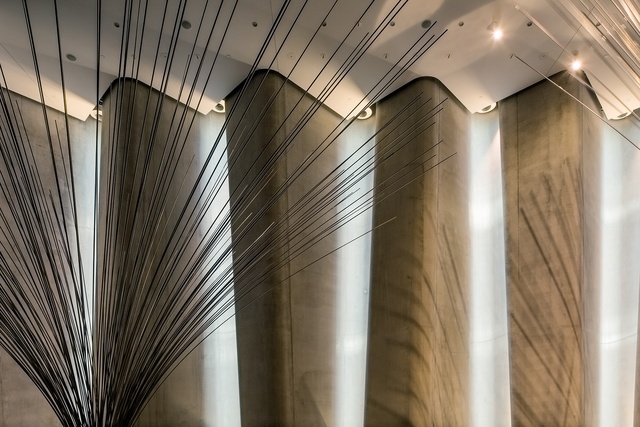
In fact, the façade tells the story of why Lye originally moved to New Plymouth, having found local collaborators with relevant technical expertise to realise his kinetic sculptures at a large scale. Local industrial stainless steel, produced for the dairy and engineering industries, transferred well into his art and also into the architecture we see today. Andrew Patterson, director of Pattersons Associates, identifies stainless steel as “essentially the local stone of New Plymouth”.
The main entrance into the reception/shop is via the adjacent Govett-Brewster Art Gallery, which was originally a 1920s’ cinema, the Regent Theatre, until, in 1970, local heiress Monica Brewster donated a large sum of money to transform the building into an art gallery for New Plymouth. Described as “a futurist”, Brewster was also a founder of another great local asset, the Pukeiti Rhododendron Trust: a public garden on the edge of Mt Taranaki.
In fact, surprisingly, this remote city has long held the arts in high regard, with its renowned coastal walkway, Wind Wand, also by Len Lye (built posthumously), Kinetika, a fusion of art, design and engineering, and WOMAD festival. Meanwhile, the lush Pukekura Park is surely the prettiest inner-city park in the country.
Instrumental in helping develop the city’s arts focus, The Len Lye Foundation instigated the Centre, with considerable funding from John Matthews, and a trust was set up for the purpose. Also, New Plymouth is fortunate to have a district council that understands that developing the cultural life of the city inadvertently means supporting its growth.
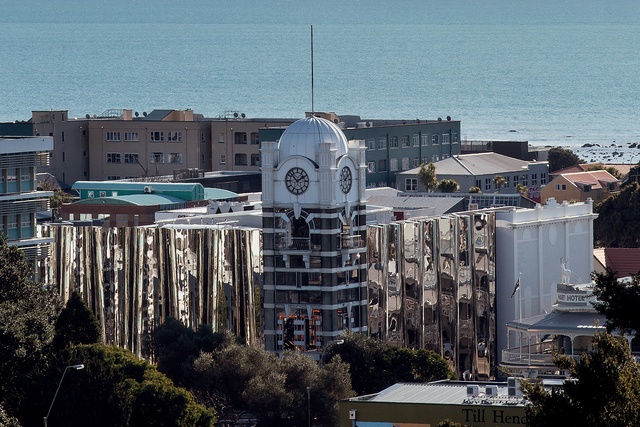
Inside the entrance is a welcoming reception desk that faces the door and, when you turn around, the retail presents itself. A processional journey then ascends along a series of ramps and into the various galleries and spaces, with no divisions in the circulation. Around the perimeter, blackout blinds on the glazed gaps between the concrete columns can be opened or shut within 10 seconds for curatorial purposes.
Along the first ramp is a door leading to an education room, the Todd Energy Learning Centre, designed to cater for around 6,500 school students each year. Next door, a 62-seat cinema, all in sumptuous red, projects Len Lye’s experimental, hand-painted celluloid films, along with Hollywood-type digital films.
Whilst designing the cinema, Pattersons had to acquire additional knowledge about film. “The theatre brief naturally evolved from just showing Len’s work into being a community facility capable of showing just about anything, including dance and theatre,” explains Mitchell.
Next up, a 9m-high gallery hosts Lye’s large kinetic work. This space has a 2m-deep well underneath the floor to house mechanisms for the artworks, while a large hatch in the roof enables a two-tonne car to be craned in and suspended from the ceiling, if required. Between the lined plasterboard walls, a 400mm cavity ensures that cabling can pop out wherever artwork needs to be fixed.
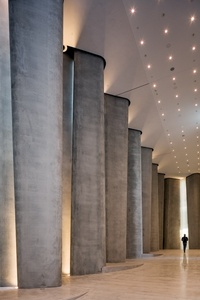
At the top of this ramp, there is a large gallery, still in the new building, and two galleries at different levels in the existing Govett-Brewster Art Gallery. These retain the feel of the older building, having been given a light-touch refurbishment. The new and existing structures are sliced apart with glazing that pulls light into this 11m-high chamber and into the educational hub. Asymmetrical bridges cross the two buildings at first-floor level.
Overall, the interior possesses a simple honesty in its materiality. No fancy finishes were applied which, of course, helped with the $17-million overall budget, including the refurbishment and earthquake strengthening of Govett-Brewster Art Gallery. Utilising local materials and expertise also ensured a competitive tender process, making this an economical build when you consider the cost of other art galleries built recently.
A particularly interesting aspect of the project was the appointment process, which Andrew Patterson described as “one of the most enlightening I’ve ever encountered on a public project” (beyond winning the bid, of course). “This was no tick-box exercise, where it becomes like shooting darts into a dartboard,” explained Mitchell.
At the start, Pattersons and a dozen other firms received phone calls to organise introduction meetings with the chair of The Len Lye Foundation, John Matthews, and Anthony Wilson from New Plymouth District Council. The long list was then reduced to a short list of four architectural firms. Each then underwent a four-hour-long interview with various stakeholders, with Sir Miles Warren offering an architectural perspective.
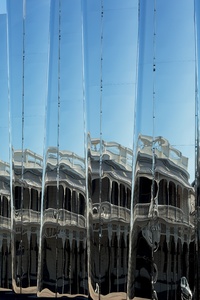
“It was a lovely process from square one,” stated Patterson. “There was no design concept at this stage; it was simply about who we are as people and can we work together?” Patterson Associates was selected and the team then spent three months in workshops with 35 stakeholders before a brief was formulated. “After three months of talking with the stakeholders, the subconscious kicked in and the design came out,” explained Patterson. “It was lovely not to burn cash and to be productive.” That intensive design process with the stakeholders meant that they ended up with “pretty much the same design result”, apart from the addition of the light slot between the buildings.
The architects believe that BIM was fundamental in working out the complex geometry of the building in three dimensions, ensuring a seamless transition from design to manufacture. eCubed Workshop’s plant room on the top of the building is huge, and no wonder, because the environmental services make up around 20 per cent of the overall build cost. This highly controlled environment requires 80 per cent relative humidity for international-standard conservation and it is well worth a tour.
A public piazza on Queen Street is expected to be completed by Christmas 2016 and will, no doubt, provide a suitable surface for those reflections to truly shine, and a place for the people of New Plymouth and, one would hope, New Zealand architecture, to meet and celebrate.
When asked what the Len Lye Centre would have been named, in keeping with his firm’s tradition of naming buildings as ‘identities’ (Anvil, Geyser, Mai Mai, etc.), Patterson says he would have called it “The Len Lye Museum” or “just The Len Lye, like a wharenui or meeting house”.

